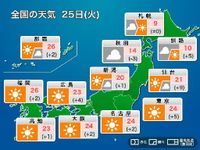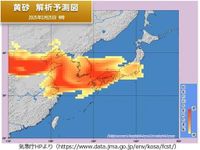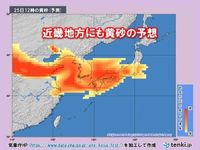As spring unfolds, residents across eastern and western Japan can expect an unusual blend of weather on March 25, 2025. This day promises to bring warm early summer temperatures, reaching up to 25°C in cities like Kyoto and Nara. However, alongside this pleasant weather lies an unwelcome visitor: yellow dust, also known as kosa, sweeping in from the Gobi Desert.
According to forecasts, the yellow dust will begin affecting Kyushu and other southern regions from late morning on the 25th, and extend north to eastern Japan, including Tohoku, by afternoon. The spread of this dust covers a significant area, raising health and safety concerns for everyone, particularly those with allergies or respiratory conditions. The Ministry of the Environment has warned that yellow dust can worsen allergy symptoms such as hay fever, urging caution among residents.
The sequence of events leading to the presence of yellow dust has its roots in the recent weather patterns observed in the Gobi Desert, where dust was raised over the previous weekend. Observations noted significantly reduced visibility, with past occurrences showing measurement drops below 2 kilometers in parts of northern China due to the dust. As the problem expands, it crosses the East China Sea and is anticipated to have a direct impact on Japan's weather by March 25.
In Japan, the early forecast for March 25 indicates that while the Kinki region may enjoy clear skies, the implications of the yellow dust will still be felt. Visibility in several locations is predicted to decline to less than 10 kilometers, with some areas seeing it dip below 5 kilometers. This situation poses a risk for transportation, especially for flights, as landing and departing aircraft may face challenges due to impaired vision.
As yellow dust blankets the country, it is expected to interfere with daily life, as residents may find their cars and laundry becoming dirty due to harsh dust particles. Those sensitive to allergies or respiratory ailments should be especially vigilant and consider remaining indoors if possible. Adequate measures, such as wearing masks when outdoors and avoiding unnecessary trips, are strongly recommended.
The atmosphere in Japan during this period will feature both warmth and discomfort, with the health implications of the dust looming large. Allergic reactions can escalate quickly, and the amount of pollen may also reach 'very high' or 'extremely high' levels. These factors compound challenges for those who suffer from environmental allergies, as the interplay of warm weather and the influx of pollutants could result in significant discomfort.
As Japan braces for the impact of the yellow dust, the meteorological department continues to monitor the situation closely, offering updates to keep the public informed. Residents are encouraged to stay updated on the weather, as conditions may change rapidly. With various regions experiencing this natural phenomenon, the response from local authorities and health organizations remains crucial to mitigate the effects on public health.
In preparation for possible disruptions, local governments and health officials are ensuring that information is disseminated, lending support to residents on how to safely navigate the upcoming days. It's essential for the public to remain proactive and take appropriate measures, such as limiting outdoor exposure when pollution levels peak.
As the dust settles across Japan on March 25, it serves as a reminder of the delicate balance between natural occurrences and our daily lives. The cohesion of warm weather and yellow dust serves not only as an environmental warning but also as a call for preparedness among the nation's citizens.





